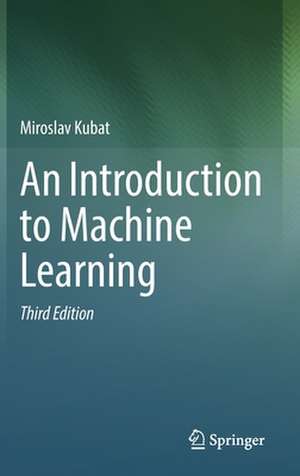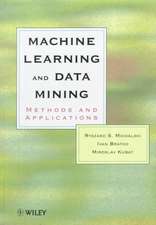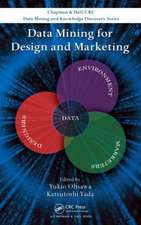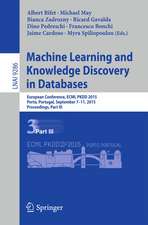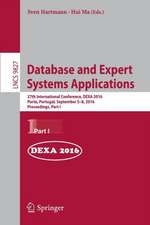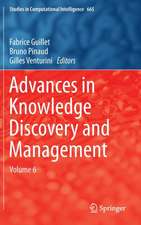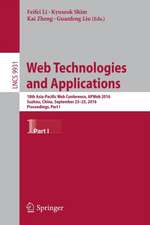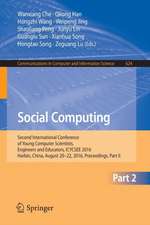An Introduction to Machine Learning
Autor Miroslav Kubaten Limba Engleză Hardback – 27 sep 2021
The main topics include Bayesian classifiers, nearest-neighbor classifiers, linear and polynomial classifiers, decision trees, rule-induction programs, artificial neural networks, support vector machines, boosting algorithms, unsupervised learning (including Kohonen networks and auto-encoding), deep learning, reinforcement learning, temporal learning (including long short-term memory), hidden Markov models, and the genetic algorithm. Special attention is devoted to performance evaluation, statistical assessment, and to many practical issues ranging from feature selection and feature construction to bias, context, multi-label domains, and the problem of imbalanced classes.
| Toate formatele și edițiile | Preț | Express |
|---|---|---|
| Paperback (2) | 333.04 lei 6-8 săpt. | |
| Springer International Publishing – 15 oct 2016 | 333.04 lei 6-8 săpt. | |
| Springer International Publishing – 18 aug 2018 | 393.58 lei 39-44 zile | |
| Hardback (1) | 375.18 lei 6-8 săpt. | |
| Springer International Publishing – 27 sep 2021 | 375.18 lei 6-8 săpt. |
Preț: 375.18 lei
Preț vechi: 468.97 lei
-20% Nou
Puncte Express: 563
Preț estimativ în valută:
71.82€ • 74.94$ • 60.21£
71.82€ • 74.94$ • 60.21£
Carte tipărită la comandă
Livrare economică 13-27 martie
Preluare comenzi: 021 569.72.76
Specificații
ISBN-13: 9783030819347
ISBN-10: 3030819345
Pagini: 432
Ilustrații: XVIII, 458 p. 114 illus., 5 illus. in color.
Dimensiuni: 155 x 235 x 35 mm
Greutate: 0.84 kg
Ediția:3rd ed. 2021
Editura: Springer International Publishing
Colecția Springer
Locul publicării:Cham, Switzerland
ISBN-10: 3030819345
Pagini: 432
Ilustrații: XVIII, 458 p. 114 illus., 5 illus. in color.
Dimensiuni: 155 x 235 x 35 mm
Greutate: 0.84 kg
Ediția:3rd ed. 2021
Editura: Springer International Publishing
Colecția Springer
Locul publicării:Cham, Switzerland
Cuprins
1. Ambitions and Goals of Machine Learning.- 2. Probabilities: Bayesian Classifiers.- 3. Similarities: Nearest-Neighbor Classifiers.- 4. Inter-Class Boundaries: Linear and Polynomial Classifiers.- 5. Decision Trees.- 6. Artificial Neural Networks.- 7. Computational Learning Theory.- 8. Experience from Historical Applications.- 9. Voting Assemblies and Boosting.- 10. Classifiers in the Form of Rule-Sets.- 11. Practical Issues to Know About.- 12. Performance Evaluation.- 13. Statistical Significance.- 14. Induction in Multi-Label Domains.- 15. Unsupervised Learning.- 16. Deep Learning.- 17. Reinforcement Learning: N-Armed Bandits and Episodes.- 18. Reinforcement Learning: From TD(0) to Deep-Q-Learning.- 19. Temporal Learning.- 20. Hidden Markov Models.- 21. Genetic Algorithm.- Bibliography.- Index.
Notă biografică
Miroslav Kubat, Associate Professor at the University of Miami, has been teaching and studying machine learning for over 25 years. He has published more than 100 peer-reviewed papers, co-edited two books, served on the program committees of over 60 conferences and workshops, and is an editorial board member of three scientific journals. He is widely credited with co-pioneering research in two major branches of the discipline: induction of time-varying concepts and learning from imbalanced training sets. He also contributed to research in induction from multi-label examples, induction of hierarchically organized classes, genetic algorithms, and initialization of neural networks. Professor Kubat is also known for his many practical applications of machine learning, ranging from oil-spill detection in radar images to text categorization to tumor segmentation in MR images.
Textul de pe ultima copertă
This textbook offers a comprehensive introduction to Machine Learning techniques and algorithms. This Third Edition covers newer approaches that have become highly topical, including deep learning, and auto-encoding, introductory information about temporal learning and hidden Markov models, and a much more detailed treatment of reinforcement learning. The book is written in an easy-to-understand manner with many examples and pictures, and with a lot of practical advice and discussions of simple applications.
The main topics include Bayesian classifiers, nearest-neighbor classifiers, linear and polynomial classifiers, decision trees, rule-induction programs, artificial neural networks, support vector machines, boosting algorithms, unsupervised learning (including Kohonen networks and auto-encoding), deep learning, reinforcement learning, temporal learning (including long short-term memory), hidden Markov models, and the genetic algorithm. Special attention is devoted to performance evaluation, statistical assessment, and to many practical issues ranging from feature selection and feature construction to bias, context, multi-label domains, and the problem of imbalanced classes.
The main topics include Bayesian classifiers, nearest-neighbor classifiers, linear and polynomial classifiers, decision trees, rule-induction programs, artificial neural networks, support vector machines, boosting algorithms, unsupervised learning (including Kohonen networks and auto-encoding), deep learning, reinforcement learning, temporal learning (including long short-term memory), hidden Markov models, and the genetic algorithm. Special attention is devoted to performance evaluation, statistical assessment, and to many practical issues ranging from feature selection and feature construction to bias, context, multi-label domains, and the problem of imbalanced classes.
Caracteristici
Offers a comprehensive introduction to the foundations of machine learning in a very easy-to-understand manner In addition to describing techniques and algorithms, each tool is applied to their appropriate situations Teaching resources include a Solutions Manual to end-of-chapter exercises, with presentation slides Request lecturer material: sn.pub/lecturer-material
Recenzii
“Miroslav Kubat's Introduction to Machine Learning is an excellent overview of a broad range of Machine Learning (ML) techniques. It fills a longstanding need for texts that cover the middle ground of neither oversimplifying nor too technical explanations of key concepts of key Machine Learning algorithms. … All in all it is a very informative and instructive read which is well suited for undergraduate students and aspiring data scientists.” (Holger K. von Joua, Google+, plus.google.com, December, 2016)
“It is superbly organized: each section includes a ‘what have you learned’ summary, and every chapter has a short summary, accompanying (brief) historical remarks, and a slew of exercises. … In most of the chapters, there are very clear examples, well chosen and illustrated, that really help the reader understand each concept. … I did learn quite a bit about very basic machine learning by reading this book.” (Jacques Carette, Computing Reviews, January, 2016)
“It is superbly organized: each section includes a ‘what have you learned’ summary, and every chapter has a short summary, accompanying (brief) historical remarks, and a slew of exercises. … In most of the chapters, there are very clear examples, well chosen and illustrated, that really help the reader understand each concept. … I did learn quite a bit about very basic machine learning by reading this book.” (Jacques Carette, Computing Reviews, January, 2016)
